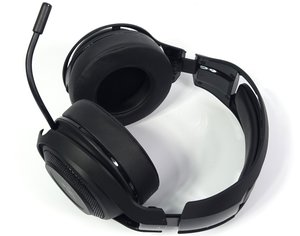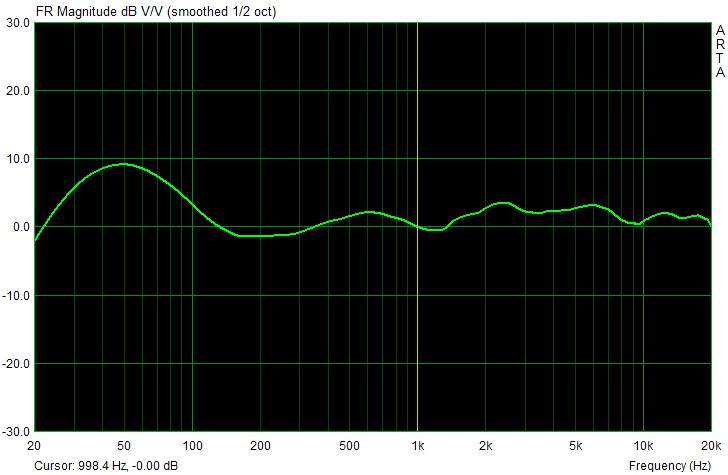Early Verdict
Our pronouncement is mostly positive, even if that's not enough for an enthusiastic purchase recommendation. There's the software and its compulsory online registration, which seem in-congruent with the $170 price tag, especially alongside the inappropriate choice of materials for this price point. Who's to say how long that faux leather and plastic will last? Razer only guarantees it for one year. The ManO'War is not a bad product, but at this price point, we'd suggest higher-end stereo headphones that you can use (and repair) for years to come.
Pros
- +
Comfortable fit
- +
Audio quality is well-matched to pure gaming
- +
Acoustic positioning & resolution are above average for gaming headsets
Cons
- -
High price
- -
Short warranty
- -
Lack of quality materials & features at this high price range, including no carrying bag, so-so material and construction, and no active noise cancelling with mic
- -
Uses the crowded 2.4 GHz frequency band for wireless communication
Why you can trust Tom's Hardware
Razer's marketing department could have come up with a more search engine-friendly spelling for its latest headset. But that's neither here nor there: the ManO'War has something to prove, since the company's Kraken wasn't exactly a stellar piece of hardware.
This time around, Razer goes all out. You may have guessed as much by the $170 list price. Fortunately, street pricing isn't as jarring. Look hard enough and you'll find the ManO'War selling for around $110.
The ManO'War is a wireless headset, though the term wireless only applies until the batteries need to be recharged. That's when you hook up the charger cable with its mini-USB connector. Also included in the bundle is a USB docking station (or extender) that either improves range by getting the wireless dongle out from behind your case or facilitates charging through its USB port.
Apart from the headset, cable, and extender, you also receive a quick-start guide and manual. A small carrying bag, which we'd expect with a $170 headset, is not included.
Specifications
If there's a silver lining on our review, it's that street pricing is down to $110, so long as you don't buy the ManO'War on Razer's own site.
Look & Feel
Although the headset is mostly plastic, Razer still makes it look nice. A predominantly matte black surface structure resists fingerprints well. It's broken up by a few piano lacquer highlights and isolated metal components (also matte black). The rest, unfortunately, is cheap polyurethane.


The ManO'War's look and feel are reasonably acceptable, even though competing products in this price range employ way better materials. Incidentally, most of them don't claim to be gaming-oriented. The durability of Razer's plastic pieces may be a matter of speculation, and a one-year warranty isn't particularly confidence-inspiring. We already found at least four potential weak spots where the ear pads are fixed to the rest of the frame.
Get Tom's Hardware's best news and in-depth reviews, straight to your inbox.


Comfort
Regardless of your head circumference, the ManO'War always fits comfortably. The downside of a perfect seal created by the soft over-ear pads, however, is a subtropical climate inside that'll leave your auricles sweating. Fortunately, the pads are only held by three pins, and are thus easy to remove and wash.


The faux leather ear pads are extremely soft, and the foam used inside adapts to your anatomy well. It's only a shame that we cannot estimate how long the polyurethane will hold its shape or resist cracking.


The headset's mechanics take some getting used to, as somewhat shaky joints develop a mind of their own when you hold them from one side only. This two-axis solution's advantage becomes apparent as soon as you adjust the fit to your head, though: as mentioned previously, it's pretty much perfect.
A weight of 374 grams is quite hefty for a wireless headset, and that becomes noticeable after longer stretches of continuous use. If you know you're sensitive to a bit of weight on your head, there's a good chance you won't enjoy the ManO'War for extended gaming sessions, even though Razer boasts of its battery life.
Connectivity
Unfortunately, the headset's radio operates in the overloaded 2.4 GHz frequency band. Modern media extenders, on the other hand, use the 5 GHz band. One reason could be that Razer seems to be using modified Bluetooth technology, which makes the ManO'War cheaper and easier to make, but not necessarily more reliable.
In rooms with mobile phones, several Wi-Fi signals, and other radio sources, this headset's practical range is considerably lower than what Razer advertises. At six to seven meters away, we were already noticing drop-outs and breakdowns, with or without the bundled extender.


We have an issue with the way Razer documents the dongle stored inside one of its ear pieces. While that may seem like a good place to keep the transmitter when it's not being used, the quick-start guide does a horrible job of explaining this. As a result, Razer's online FAQs spell it out more clearly for customers wondering why they're missing the dongle.
The right ear piece also hosts a a continuously adjustable volume control. Its tactile feedback unfortunately does not correspond to anything really, so you're left to rely on Windows' software slider for a better idea of range. However, the idea to integrate a mute button for turning sound off altogether is a good one.
Similar controls for the microphone are built into the left ear piece. Although they're well-intentioned, this implementation isn't optimal in our opinion. In addition to those controls, the left side also hosts the mini-USB socket and an on/off button with a status LED. Right next to it is the pull-out microphone.
Microphone
A simple omnidirectional electret microphone has no pop protection and is placed at the end of a short gooseneck with limited flexibility. Nevertheless, the microphone adjusts to your anatomy quickly and easily, even if a greater distance from your mouth allows the surrounding environment to be heard more than we'd like.
A low cut at ~100 Hz works well. Thus, the typical rumble of wind and blow-out noises shouldn't be a problem. Active noise canceling is unfortunately not part of what you get for $170, and that's incomprehensible to us given what Razer charges for its ManO'War.
Drivers
We've previously discussed the fact that Razer requires online access and compulsory registration for its Synapse configuration software. We're not particularly happy about this forced marriage, and that should come as no surprise by now, even if we did praise Synapse for the cloud-based convenience it enables.
Nevertheless, the software is still riddled with technical shortcomings, such as an insufficiently split equalizer. We also have little patience for a driver installation that takes three minutes on a high-end gaming PC with 200 Mb/s connectivity.
There's good news, though: as soon as the dongle is in, you'll hear sound even without installing Razer's drivers. Sure, it's just normal two-channel stereo. But in our experience, simulated 7.1-channel audio isn't much of a loss to begin with. Perhaps the ManO'War will change our minds.
Measurements & Sound-Check
To read about our test methodology in depth, please check out How We Test Gaming Headsets, particularly page 6 where we detail the measurements we take.
A first glance at the results collected in our audio lab reveal the familiar bathtub shape. At least this time we don't encounter an unnecessarily deep curtsy in the lower-mid range.
As a result, the headset sounds slightly more broadband. It's more like an acoustic paddling pool than a narrow tub. The edges do exhibit an emphasis on bass and treble, which turns out a bit too heavy in the bass range. Yet, it's still low enough at 50 to 60 Hz to prevent a cardboard-sounding upper-bass response.
It is precisely this overemphasis that converts the bass drum into a weapon while listening to music. Everything else is pushed into the background. Such a setup isn't bad during games since the headset does offer great level stability and acceptable transient response, which complement each other well. For once, we'd go so far as to call the gaming headset label appropriate. Gaming is indeed fun with Razer's ManO'War.
Getting back to Synapse and its integrated equalizer. On one hand, its lowest control point is way too high at 125 Hz. This doesn't make sense, as even a simple Realtek codec is configurable down to 32 or 64 Hz. On the other hand, the curve's maximum/minimum is, in practice, miles away from what the labels actually say.
Razer's developers don't have much music sense. Stored sound profiles like "Classic" or "Jazz" are testaments to that. While we were able to compensate for almost all of the nasty acoustic manipulation, despite the equalizer's limited capabilities, there is a limit to what can be done about that bass.
Otherwise, there's little for us to complain about. In addition to amazing sound neutrality above 250 Hz, the ManO'War scores points for detailed reproduction of voices and instruments.
The overemphasis of high frequencies between 6 and 8 kHz is a matter of taste. Sibilants are already well-pronounced without sounding metallic. This does, however, expose the lack of quality when you're listening to poor MP3 recordings. Even neophytes will notice the limitations of lower bit rates (even if that's more of an argument for, rather than against this headset).
Acoustic positioning and resolution are above average for a gaming headset. Latency is also acceptable. That's not always a given for wireless headsets, so we appreciate it.
All in all, the ManO'War's acoustic qualities are quite acceptable, so long as you're willing to accept the flaws in musical reproduction alongside the solid gaming performance. Our only real criticism is the audible residual noise, which can still be heard with the volume turned all the way down. That just isn't appropriate for a modern headset selling for $170.
Conclusion
Even though we've poked at a number of issues, the ManO'War is a functional gaming headset that's good enough for music, so long as you enjoy heavy bass.
Wireless functionality provides a small taste of freedom, even if the range isn't enough to walk to another room. If you need to grab a snack in the kitchen, take the headset off first.
Our final verdict is mostly positive, even if that's not enough for an enthusiastic purchase recommendation. We're forced to weigh pros and cons. There's the software and its compulsory online registration, which fail to deliver on what you'd expect after spending $170 on a headset. Consider also the inappropriate choice of materials for this price point. Who's to say how long that faux leather and plastic will last? Razer only guarantees it for one year.
The ManO'War is not a bad product per se. Quite the opposite, really. But for its price, we can't help suggesting higher-end stereo headphones that you can use (and repair) for years to come.
MORE: Best Deals
MORE: Best PC Builds

Igor Wallossek wrote a wide variety of hardware articles for Tom's Hardware, with a strong focus on technical analysis and in-depth reviews. His contributions have spanned a broad spectrum of PC components, including GPUs, CPUs, workstations, and PC builds. His insightful articles provide readers with detailed knowledge to make informed decisions in the ever-evolving tech landscape






